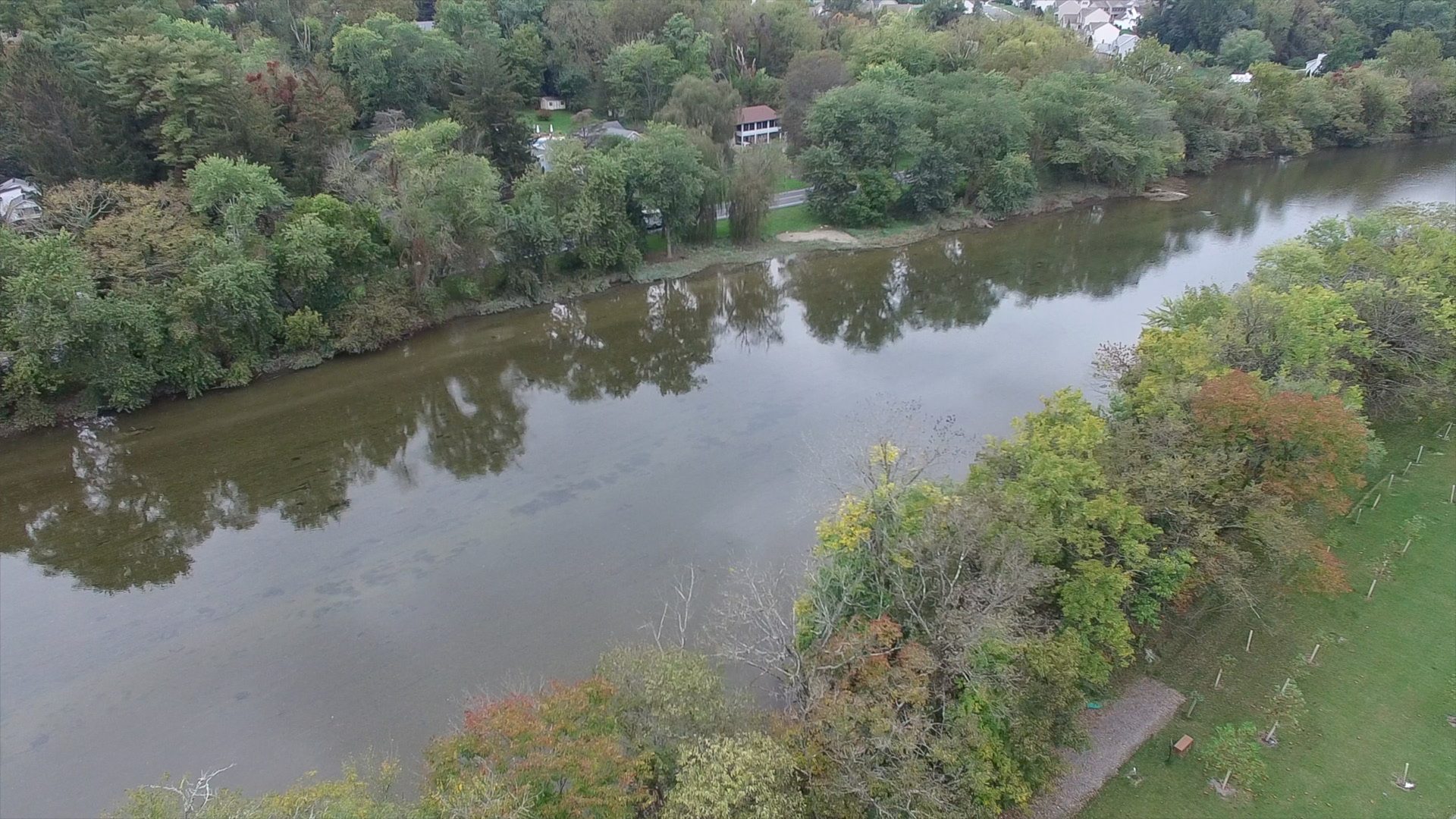
This view of the Conodoguinet Creek outside Harrisburg shows the shoreline close to homes. Climate change is predicted to bring more frequent and heavier rains, which means a rising creek could threaten nearby roads and homes.
Doug Watson / WITF


This view of the Conodoguinet Creek outside Harrisburg shows the shoreline close to homes. Climate change is predicted to bring more frequent and heavier rains, which means a rising creek could threaten nearby roads and homes.
Doug Watson / WITF

Doug Watson / WITF
This view of the Conodoguinet Creek outside Harrisburg shows the shoreline close to homes. Climate change is predicted to bring more frequent and heavier rains, which means a rising creek could threaten nearby roads and homes.
A group in Cumberland County is working to get more people involved in caring for waterways.
The Conodoguinet Creek runs for about 100 miles through Franklin and Cumberland counties before meeting the Susquehanna River near Harrisburg.
A project called Creek Defenders, led by the group Move Past Plastic, is seeking volunteers to gather information on pollution and its possible sources along the creek.
The group’s founder, Tamela Trussell, said the goal is to combine citizen science with existing data from regulatory bodies.
“Information is in so many places and not really accessible for the community members or leaders or watershed organizations,” Trussell said.
Through the project, the group aims to teach people how to identify known and potential pollution sources. It aims to raise awareness of the possible environmental and health impacts of chemical and physical pollution.
Those who want to get involved can find more information and fill out pollution reports on Move Past Plastic’s website.
Trussell said the pollution report form can be used to identify inappropriate burning or dumping of litter, tires, electronics, bedding, or construction material. People can also report finding small plastic building blocks known as nurdles, as well as chemicals, fish kills, strange colors or smells in water, stormwater erosion, and leaks from the petrochemical industry.
Trussell said the group will work with partners to investigate the reports and map them.
Trussell said the all-volunteer core team is invaluable for making the project happen. The group is working with a community science fellow and three community scientists.
MPP created the project proposal with the Environmental Protection Network, a nonprofit group of former Environmental Protection Agency staff that provides subject-matter expertise. The project is funded by a grant from the American Geophysical Union’s Thriving Earth
Exchange, which aims to support community science.
Elizabeth Southerland was with the EPA for 30 years, serving as director of science and technology in the agency’s Office of Water, before retiring in 2017.
She called the Creek Defenders project an excellent example of a watershed monitoring program.
She said EPN often advises on which pollutants should be monitored based on discharges and land use in each watershed and at what concentrations those pollutants present a concern.
“EPN prioritizes technical assistance to communities because we are well aware that states and the federal government often lack the resources to investigate pollution at every location where problems are suspected,” Southerland said.
The group plans to create an interactive map of the creek and its watershed to show the source of risks to health and the environment.
The group also plans to release a report with recommendations for creek remediation and protection by April 2025.
Trussell hopes this effort can be a model for other watersheds.
“The idea is to come together as a whole entire community to try to address pollution before it becomes part of the environment,” she said.
Pollution already threatens many waterways in Pennsylvania. More than 28,000 miles, or 34%, of streams in the state are considered impaired. The Department of Environmental Protection’s latest Water Quality Monitoring Report says the top sources are agriculture, acid mine drainage, and urban runoff.
Last year, a report from the U.S. Geological Survey found 76% of 161 Pennsylvania rivers and streams tested had one or more kinds of PFAS, known as “forever chemicals.” The chemicals have been widely used for products such as waterproof clothing, nonstick cookware, and firefighting foam. They take a very long time to break down in the environment and have been linked to health risks such as cancer.
Steve Hvozdovich with Clean Water Action said the Creek Defenders program is an example of public participation that has been a cornerstone of effective government engagement and industry accountability.
“These types of projects have also taken on a more important role in the context of DEP’s ongoing funding shortfalls,” Hvozdovich said. “The DEP Clean Water Program staff recently reported they need at least 20 more stream biologists to add to the 20 stream biologists they currently have. Currently, the program has enough staffing to inspect streams only once every 30 years. Inspections should be done about once every 5 years.”
StateImpact Pennsylvania is a collaboration among WITF, WHYY, and the Allegheny Front. Reporters Reid Frazier, Rachel McDevitt and Susan Phillips cover the commonwealth’s energy economy. Read their reports on this site, and hear them on public radio stations across Pennsylvania.
(listed by story count)
StateImpact Pennsylvania is a collaboration among WITF, WHYY, and the Allegheny Front. Reporters Reid Frazier, Rachel McDevitt and Susan Phillips cover the commonwealth’s energy economy. Read their reports on this site, and hear them on public radio stations across Pennsylvania.
Climate Solutions, a collaboration of news organizations, educational institutions and a theater company, uses engagement, education and storytelling to help central Pennsylvanians toward climate change literacy, resilience and adaptation. Our work will amplify how people are finding solutions to the challenges presented by a warming world.